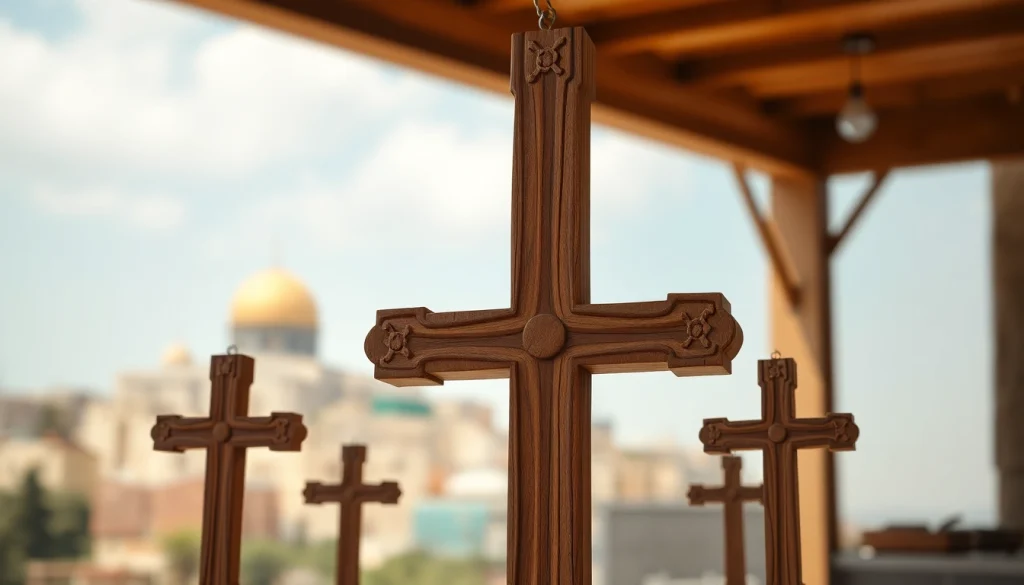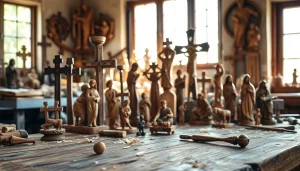The Rich Symbolism and History Behind Jerusalem Crosses

Understanding Jerusalem Crosses: Definitions and Variants
What are Jerusalem Crosses?
The Jerusalem cross, also known as the “five-fold cross” or “cross-and-crosslets,” is a distinctive Christian symbol featuring a large central cross potent, which is surrounded by four smaller Greek crosses, one positioned in each quadrant. This design echoes the core message of Christianity, signifying the Gospel’s spread to the four corners of the world, making it a powerful emblem for believers. Often associated with the City of Jerusalem, the cross not only represents the city’s historical and religious significance but also serves as a visual representation of the faith’s reach and ambitions.
The symbol originated in the 11th century during the Crusades, although traces of similar designs appear in early Christian art and architecture. Notably, the Jerusalem cross has come to represent the various teachings of the four Evangelists: Matthew, Mark, Luke, and John, encapsulating the essence of the scriptures and the message of salvation. For more information about the rich history and significance of Jerusalem crosses, one can consult various resources available today.
Variants of Jerusalem Crosses in Different Cultures
The versatility of the Jerusalem cross has allowed it to adapt and resonate differently across cultures. In Eastern Orthodox Christianity, the cross is often featured in iconography and religious artifacts, symbolizing not only the triumph of Christ over death but also the divine guidance that believers seek. Furthermore, different regions have their unique interpretations of the Jerusalem cross. For instance, in some African and Asian cultures, the cross integrates local artistic styles and materials, imbuing it with additional layers of significance.
Similarly, within the Western Christian traditions, variations of the cross can be seen in various denominational artifacts, from jewelry to church decorations, often incorporating local artisan skills that reflect the region’s heritage and artistry.
Significance in Christian Symbolism
The theological implications of the Jerusalem cross are profound. It symbolizes the hope of eternal life through Christ’s sacrifice, embodying the fundamental Christian belief in resurrection and redemption. Each of the four smaller crosses not only represents the four evangelists but also serves as a reminder that the teachings of Jesus are meant to reach every person globally. This aspect emphasizes the universality of the Christian message, fostering a sense of unity among believers no matter their geographical or cultural background.
Moreover, the Jerusalem cross has become a symbol of pilgrimage, particularly for those seeking to visit the Holy Land. Pilgrims carrying this emblem showcase their spiritual journey and commitment to living out their faith while encouraging others to embrace the journey of justice, peace, and reconciliation.
Historical Context of Jerusalem Crosses
Origins and Development Through the Ages
The origins of the Jerusalem cross can be traced back to the early Crusades when Christian knights and pilgrims sought to reclaim Jerusalem from Muslim control. The symbol emerged during this turbulent period as an affirmation of Christian identity and an expression of the hope that fueled the Crusaders. Historical accounts often associate the cross with the Kingdom of Jerusalem, established post-Crusade, becoming a heraldic emblem that adorned flags and shields.
Over centuries, the Jerusalem cross evolved, transitioning from its militaristic roots to embrace a more spiritual identity. In art, literature, and architecture, the cross began to symbolize not just conquest, but the spiritual resilience and faith of Christians in the region, deepening its ties to the essence of Christian teachings.
Historical Significance During the Crusades
During the Crusades, the Jerusalem cross emerged as a rallying point for many European Christians. It was not only a mark of piety but also reflected the political and social aspirations of the time. Each Crusader identifying with the Jerusalem cross underscored their mission’s spiritual legitimacy, which was often believed to culminate in the salvation of their eternal souls. As such, the cross became a symbol of hope intertwined with the harsh realities of war, encapsulating the turbulence of these historical events.
Furthermore, the tactical use of the Jerusalem cross in military insignia during this period marked it as a significant icon, fostering unity among soldiers and instilling a courageous spirit for those involved in the battles to reclaim the Holy Land.
Modern Interpretations and Uses
In contemporary society, the Jerusalem cross has found new life as a symbol of hope, love, and unity in diversity. It transcends its historical constraints, appearing in various contexts far removed from the battlefield, from personal jewelry and art to community events and religious services. The design’s beauty and complexity resonate deeply, making it a favorite among artists and artisans who seek to express faith through their creativity.
Many modern interpretations embrace ecumenism, promoting dialogue among different Christian traditions and even extending goodwill towards other faiths. The Jerusalem cross, thus, serves as a bridge between communities, fostering a shared sense of belonging and mutual respect that can overcome historical divides.
Craftsmanship of Jerusalem Crosses
Materials Used in Making Jerusalem Crosses
The craftsmanship behind Jerusalem crosses showcases a profound appreciation for materials and tradition. Artisans primarily use olive wood sourced from the Holy Land, a material rich in symbolic meaning, representing peace, prosperity, and resilience. Olive wood is known for its unique grain and texture, adding an organic feel to each piece, which enhances both aesthetic and prayerful qualities.
Additionally, precious metals like gold and silver often create more luxurious interpretations of the Jerusalem cross. These materials not only elevate the artwork but also signify the sacredness and value attributed to the symbol. Various stones, often emblematic of the Holy Land, are sometimes integrated into these crosses, further enhancing their beauty and spiritual relevance.
Exploring Traditional Craftsmanship Techniques
The creation of Jerusalem crosses involves a combination of traditional craftsmanship and artistry passed down through generations. Methods such as hand-carving and intricate engraving are common, with artisans often utilizing chisels, knives, and other hand tools to achieve remarkable detail in their designs. The process is meticulous, requiring both skill and patience, ensuring that each piece is not only an object of beauty but also a vessel of spiritual significance.
The meticulous tradition also encompasses the religious and cultural practices that surround the making of these crosses. Many artisans incorporate prayers and rituals during the crafting process, infusing each cross with intentions that extend beyond the physical creation.
How to Care for Your Jerusalem Cross
To maintain the beauty and integrity of your Jerusalem cross, proper care is essential. Here are some tips for preserving your cross:
- Avoid Excessive Moisture: Keep the cross away from direct water exposure. If it becomes wet, dry it promptly with a soft cloth.
- Store Properly: When not in use, store the cross in a cool, dry place, preferably in a soft cloth pouch to prevent scratches.
- Regular Cleaning: Use a soft, dry cloth to gently clean the surface. Avoid harsh chemicals and abrasive materials that could damage the finish.
- Avoid Direct Sunlight: Prolonged exposure to sunlight can fade the colors and damage the materials. Display the cross in a shaded area.
By following these guidelines, you can ensure that your Jerusalem cross remains a cherished symbol of faith for years to come.
The Spiritual and Cultural Impact of Jerusalem Crosses
Jerusalem Crosses in Art and Literature
The Jerusalem cross has inspired numerous artistic and literary works throughout history. From ancient manuscripts featuring intricate illustrations of the cross to modern paintings that explore its thematic significance, the symbol has cultivated a rich presence in various media. Many artists draw upon its geometric form and deep symbolism to convey messages of faith, hope, and reconciliation.
In literature, the Jerusalem cross frequently appears as a metaphor for journey and discovery, often representing the quest for spiritual truth. It is not uncommon for authors and poets to use the symbol as a backdrop for narratives exploring themes of redemption and the human condition.
Influence on Contemporary Religious Practices
In today’s religious practices, the Jerusalem cross serves as a central element for many Christian communities who adopt it into worship, ceremonial activities, and community outreach programs. Its prominence in church services, processions, and pilgrimages emphasizes its significance as a source of inspiration and unity among believers.
Moreover, the cross often functions as a focal point for educational programs that delve into Christian history, providing insight into the faith’s rich narrative and its expansion across cultures. Through discussions surrounding the Jerusalem cross, congregations foster a deeper understanding of the tenets of Christianity, exploration of historical contexts, and appreciation of cultural diversity.
Jerusalem Crosses as Symbols of Peace and Unity
The message of peace and unity embodied in the Jerusalem cross makes it a potent symbol in contemporary conversations around interfaith dialogue and collaboration. Many religious leaders promote the cross as an emblem of goodwill, encouraging communities to come together across denominational lines to work towards shared goals of harmony and understanding in an increasingly polarized world.
Through community events and collaborative efforts, the Jerusalem cross fosters connections between different faiths, inviting shared reflection on values such as compassion, love, and respect for one another. As a lasting legacy of its multi-layered significance, the cross is not merely an artifact of the past, but a living symbol guiding the journey towards peace and unity in modern-day discussions.
Where to Buy Authentic Jerusalem Crosses
Online Retailers for Jerusalem Crosses
When seeking authentic Jerusalem crosses, several reputable online retailers specialize in these symbolic pieces. Websites often provide detailed descriptions and images to ensure that customers can select pieces that resonate with their personal spiritual journeys. Additionally, online marketplaces focused on artisanal crafts may offer handmade options, enhancing the connection between the buyer and the maker.
Local Shops and Artisans in Jerusalem
For those traveling to Jerusalem, exploring local shops and artisan workshops is an excellent way to obtain a genuine Jerusalem cross. Many artisans invite visitors into their studios, allowing individuals to witness the craftsmanship firsthand while learning about the cultural significance of the cross. This immersive experience not only enhances the value of the purchase but also supports local economies and preserves traditional craftsmanship.
Tips for Spotting Genuine Jerusalem Crosses
When purchasing a Jerusalem cross, whether online or in person, it is crucial to ensure authenticity. Here are some tips to consider:
- Research the Seller: Look for reviews and testimonials about the seller’s authenticity and reputation.
- Material Quality: Genuine Jerusalem crosses are often made from high-quality materials like olive wood or precious metals. Check for the craftsmanship and detail in the design.
- Documentation: Authentic pieces often come with certificates of authenticity or documentation that verifies their origin and craftsmanship.
- Pricing: Be cautious of prices that seem too low for the quality offered; a genuine Jerusalem cross often reflects its quality and craftsmanship in its price.
With these tips in mind, you can confidently select a Jerusalem cross that reflects not only your personal spirituality but also honors the rich heritage behind this remarkable symbol.






